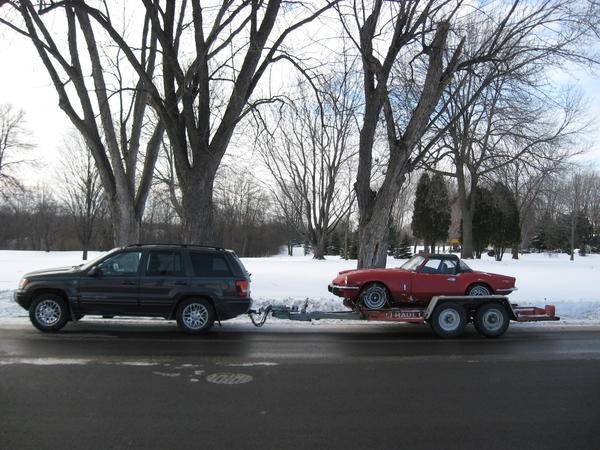Transporting a classic car like a Triumph Spitfire requires careful planning and execution. While a U-Haul car trailer might seem like the obvious choice, U-Haul’s website often recommends a car dolly instead. This article explores the feasibility and challenges of using a U-Haul car dolly for this purpose, drawing on real-world experiences and expert advice.
Can a Triumph Spitfire Fit on a U-Haul Car Dolly?
The short answer is: it’s complicated. A Triumph Spitfire’s narrow track width (around 41 inches between tires) presents a unique challenge. While the car itself might fit within the width constraints of a U-Haul car trailer, it often doesn’t align with the standard tire tracks or wheel wells designed for wider vehicles. This makes securing the car with the provided straps difficult. U-Haul’s online resources may even explicitly advise against using a car trailer for a Spitfire, recommending a dolly instead.
Why U-Haul Might Recommend a Dolly and What to Consider
U-Haul’s recommendation for a car dolly stems primarily from liability concerns. If the Spitfire doesn’t fit securely within the designated wheel tracks of their car trailers, they might be hesitant to endorse its use. However, many Spitfire owners have successfully transported their cars using U-Haul car trailers by employing alternative securing methods.
If considering a car trailer, keep these points in mind:
- Manual Transmission Requirement: U-Haul typically requires manual transmission vehicles to be transported on a car trailer. This is because towing a rear-wheel-drive car with an automatic transmission on a dolly can damage the transmission due to lack of lubrication. A Spitfire’s manual transmission makes it compatible with a trailer in this regard.
- Securing the Car: Since the Spitfire’s narrow track width prevents using the standard wheel straps, you’ll need to employ alternative methods like ratchet straps and additional tie-down points to ensure the car is completely secure. Consider using wheel nets for added stability.
- Ramp Width: The ramps on U-Haul car trailers can be wider than the Spitfire’s track width. This can make loading and unloading tricky. Carrying extra boards to bridge the gap can be beneficial. Approach the ramps slowly and at a slight incline if possible.
Using a U-Haul Car Dolly: Potential Issues
While a dolly might seem like the U-Haul-approved solution, it comes with its own set of challenges for a Spitfire:
- Driveshaft Removal: Towing a rear-wheel-drive car on a dolly requires disconnecting the driveshaft to prevent damage to the transmission during transport. This adds an extra layer of complexity and requires mechanical knowledge or professional assistance.
- Steering Lock: Ensure the steering wheel is locked or secured straight ahead to prevent unwanted movement during towing.
Best Practices for Towing a Triumph Spitfire
Regardless of whether you choose a dolly or a trailer, these best practices are crucial:
- Tow Vehicle Capacity: Ensure your tow vehicle has the necessary capacity to safely tow the Spitfire and the chosen transport method.
- Safety Chains: Always use safety chains as a backup in case the primary connection fails.
- Proper Lighting: Verify that all trailer lights are functioning correctly.
- Tire Pressure: Check the tire pressure of both the tow vehicle and the trailer or dolly.
Conclusion: Making an Informed Decision
Transporting a Triumph Spitfire with a U-Haul car dolly or trailer presents specific challenges due to the car’s dimensions. While a dolly might seem like the default option based on U-Haul’s recommendations, a car trailer can be a viable alternative with careful planning and proper securing techniques. Ultimately, the best choice depends on your comfort level with mechanical tasks, the capabilities of your tow vehicle, and your willingness to take extra precautions to ensure a safe and successful transport. Always prioritize safety and consult with U-Haul directly to clarify their policies and recommendations before making a reservation.

